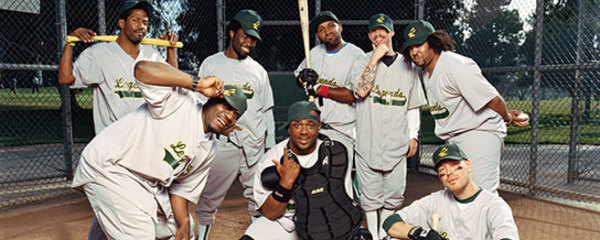The Living Legends’ Hip-Hop Masterpiece
What a long, strange trip it’s been. The Living Legends have grown considerably since 1997, […]
The Living Legends’ Hip-Hop Masterpiece
What a long, strange trip it’s been. The Living Legends have grown considerably since 1997, […]

What a long, strange trip it’s been. The Living Legends have grown considerably since 1997, when they germinated in the now-famous San Leandro Avenue “Outhouse” in East Oakland’s Fruitvale District. Now numbering nine members–Sunspot Jonz, Luckyiam, Eligh, The Grouch, Bicasso, Aesop the Black Wolf, Murs, Arata, and Scarub–they’ve been called a West Coast Wu-Tang, more for their Voltron-like collective philosophy than stylistic similarities. Like the Wu, they’ve branched out into various subgroups (including CMA, Mystik Journeymen, G&E, and 3MG), yet they might have more in common with indie comrades Hieroglyphics, Rhymesayers, and Def Jux, who, along with the LL crew, have defined quality underground hip-hop for the last decade.
“That’s not bad company,” says Luckyiam, over the phone from LA. Yet while the Legends have turned their crew name into a self-fulfilling prophecy, they’re far from done. “We want to take it even farther,” says The Grouch, adding that their efforts up to now have merely been “laying the groundwork for what is to come.”
The next phase in their quest to manifest their own destiny is Classic, a group album recorded the way few people record group albums anymore. The entire crew holed up in a beach house in Maui for a month to create what is easily their finest artistic statement yet. The album’s title is perhaps best outlined on “Blast Your Radio,” which explains that retro doesn’t automatically mean classic, and that classic doesn’t necessarily mean old.
Amazingly, for an album with nine distinct voices on it (plus some outside production by Madlib, DJ Epic, DJ Khalil, and Beam One), Classic resonates with the kind of solidarity that only comes from a concerted group effort. “This one was a lot more cohesive” than previous efforts, The Grouch notes, the main difference being “the actual experience of everybody being in the same house at once.”
Luckyiam mentions that making Classic took the group back to their humble (i.e. hella broke) beginnings in the Outhouse days, when their creative juices first flowed. Perhaps most importantly, it renewed their camaraderie–not just as recording artists, but also as friends. “Everyone has their own unique place in this,” he says. To the Grouch, what makes the Legends special is their normalcy; “people get the feeling that our group is made up of real people,” he notes. And, as the saying goes, real people do real things.

